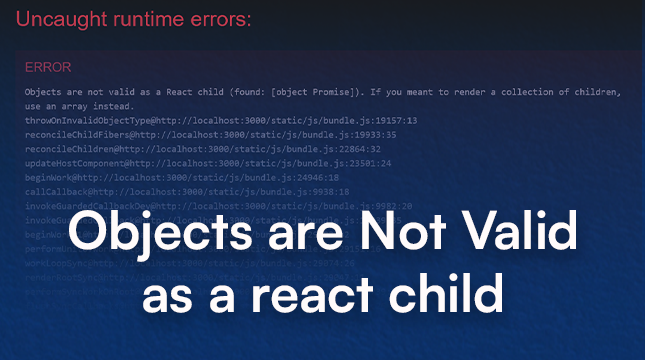This website uses cookies so that we can provide you with the best user experience possible. Cookie information is stored in your browser and performs functions such as recognising you when you return to our website and helping our team to understand which sections of the website you find most interesting and useful.
The Complete Guide to Fixing “Objects are not valid as a React child”

The mysterious error “Objects are not valid as a React child (found: object)” may appear. Take a deep breath. “Use an array if you intend to render a collection of children.” You’ve encountered one of the most prevalent and resolvable React errors.
This message is React’s way of telling you that it is unable to visually represent something you have attempted to add to the Document Object Model (DOM) of the browser; it is not a critical failure. By mastering this fix, you can focus on the performance of your application and explore modern tooling to streamline your development environment, such as starting a new Vite React app.
The error typically indicates a straightforward error: you are trying to render a standard JavaScript object directly somewhere in your JSX.
The Root Cause: What React Expects to Render
To understand the fix, you must first understand the Fundamental React Rendering Rule. This explicit approach to data representation is one of the core principles that sets this library apart from other frameworks. If you’re curious about the bigger picture, explore the difference between Angular vs. React and why millions of developers choose React.
React components expect their children (the elements nested inside your JSX tags) to be one of the following four valid data types that can be directly translated into a browser DOM element:
- Primitives (string or number): React renders these as text nodes.
Example: <div>{100} products</div> - Booleans, null, or undefined: These are valid but render absolutely nothing to the DOM. They are often used for conditional rendering.
Example: <div>{isAdmin && <AdminPanel />}</div> - Arrays: A collection ([]) of other valid children (Primitives or React Elements). React simply renders each item in the array sequentially.
- Valid React Elements: These are your custom components (<MyComponent />) or standard HTML-like tags (<div>, <p>, <span>).
Why React Rejects Objects
A plain JavaScript object, like a user profile ({ id: 1, name: “Alice” }), has no inherent visual representation. If you attempted to render the entire object, what should the browser display? [object Object]? React throws the error to prevent this undesirable, often corrupted, DOM output.
The fix, therefore, is always to ensure you are accessing a valid child property from the object, rather than the object itself.
Top 3 Error Scenarios & Integrated Fixes
This error almost always stems from one of these three common coding mistakes. We’ll show you the mistake and the correct, effective solution.
1. Accidentally Rendering the Entire Data Object
This is the simplest form of the error, often occurring when accessing a prop or state variable that holds data.
The Mistake
You’ve passed a user object as a prop and tried to render it directly inside your component:
// Assume userData is an object like { id: 5, name: "Jane" }
const UserProfile = ({ userData }) => {
return (
<div>
{/* ERROR: Attempting to render the full object */}
User Data: {userData}
</div>
);
};
The Fix: Access a Specific Property
Always ensure you are accessing a string or number property inside the object.
const UserProfile = ({ userData }) => {
return (
<div>
{/* FIX: Accessing the name property (a string) */}
User Name: {userData.name}
</div>
);
};
2. Incorrect Array Mapping (Forgetting to Return JSX)
This is the most frequent cause. When using the .map() array method, you must explicitly return a valid piece of JSX (an Element) for every iteration, not the raw data object.
The Mistake
The developer forgot to wrap the item in a JSX tag inside the map() callback:
const users = [
{ id: 1, name: "Alice" },
{ id: 2, name: "Bob" },
];
<ul>
{/* ERROR: The map function is returning the raw user object */}
{users.map((user) => user)}
</ul>
The Fix: Map to a Valid JSX Element
Wrap the data in an element like <li> and remember the mandatory key prop.
const users = [
{ id: 1, name: "Alice" },
{ id: 2, name: "Bob" },
];
<ul>
{/* FIX: Returning a valid <li> element with the necessary key */}
{users.map((user) => (
<li key={user.id}>User: {user.name}</li>
))}
</ul>
Key Reminder: The key prop is essential when rendering lists. It allows React to efficiently identify which items have changed, been added, or been removed, optimizing performance.
3. Accidental Object Return in Conditional Logic
If your conditional logic (like a ternary operator) evaluates to an object in one of its branches, the error will occur.
The Mistake
Attempting to return a configuration object instead of a rendering element:
// config is an object used elsewhere
const config = { message: "Action Required" };
const needsAttention = true;
return (
<div>
{/* ERROR: If true, the entire 'config' object is returned */}
{needsAttention ? config : null}
</div>
);
The Fix: Return a String or JSX Element
Ensure both sides of your conditional statement return either a valid React Element, a string, or null.
const config = { message: "Action Required" };
const needsAttention = true;
return (
<div>
{/* FIX: Returning the message string from the config object */}
{needsAttention ? config.message : null}
</div>
);
Pro Tips for Prevention & Advanced Rendering
Once you’ve mastered the basics, these advanced techniques will help you write cleaner code and perform preventative debugging, ensuring the “Objects are not valid” error never sneaks back into your components. Writing clean, predictable frontend code is a foundational step for building scalable web applications with ReactJS and NodeJS.
1. Process Data Before You Render
Avoid complex object manipulation or transformations inside your return() statement. Instead, process all necessary data and logic before the JSX rendering phase. This keeps your JSX clean and guarantees you are passing only valid primitives or elements.
// Avoid complex logic inside the return
// return <div>{data.status === 'OK' ? data.message : getErrorObject(data).text}</div>
const MyComponent = ({ data }) => {
// 1. Process the object outside of the JSX
const displayMessage = data.status === 'OK'
? data.message
: getErrorObject(data).text;
return (
<div>
{/* 2. Render the clean, processed string */}
<p>{displayMessage}</p>
</div>
);
};
2. Defensive Rendering with Optional Chaining (?.)
When accessing deeply nested properties, the error can sometimes occur if a parent object is unexpectedly null or undefined. Accessing a property (.) on an empty value results in a runtime error, which can disrupt React’s rendering.
The Optional Chaining operator (?.) safely returns undefined if a property is missing. Since React ignores undefined (it renders nothing), this prevents the application from crashing.
// Assume user is undefined when the data hasn't loaded yet
// Crashes: Tries to access profile.name on undefined 'user'
// <div>{user.profile.name}</div>
// Fix: Uses Optional Chaining for safe, silent failure
<div>User Name: {user?.profile?.name}</div>
3. The Debugging Trick: JSON.stringify()
If you absolutely must see the contents of an object for debugging purposes, you can temporarily convert it into a string that React can render.
Warning: This should only be used during development to inspect a variable’s value. Never commit code to production that uses JSON.stringify() for general rendering.
const userObject = { id: 101, status: 'Active' };
// Debugging only! Converts the object to a renderable JSON string
<div>Debugging Data: {JSON.stringify(userObject, null, 2)}</div>
Conclusion
The “Objects are not valid as a React child” error is a valuable lesson in the strict contract between your code and the React renderer. It forces you to be explicit about what should appear in the DOM.
By adopting these practices, you’ve gained mastery over React rendering:
- Always access a primitive (.name, .id) from an object, never the whole object.
- Use the .map() method correctly by always returning a valid JSX element with a unique key.
- Implement defensive coding using the ?. operator to gracefully handle missing data.
Keep these rules in mind, and you’ll write more reliable, efficient, and error-free React applications, whether you’re building a simple marketing site or looking at the benefits of using React Native for Fintech app development.

Let's Start Your Project
Get free consultation for your digital product idea to turn it into reality!
Get Started






